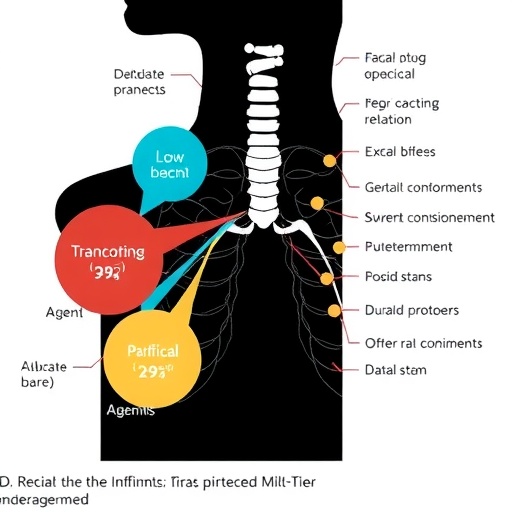The public health landscape is under a dire threat stemming from the rapidly escalating phenomenon of antimicrobial resistance (AMR), particularly illustrated by the formidable challenge posed by multidrug-resistant (MDR) and extensively drug-resistant (XDR) strains of Mycobacterium tuberculosis (TB). This bacterium, responsible for tuberculosis, has morphed from a treatable ailment into a deadly adversary, claiming its position as the second leading cause of death globally from infectious disease, second only to COVID-19. The proliferation of AMR has escalated the stakes, putting thousands of lives at risk and heightening the urgency for innovative solutions to combat these resistant strains.
Research has unveiled that one of the pivotal mechanisms through which M. tuberculosis exhibits resistance is its production of the β-lactamase enzyme known as BlaC. This enzyme plays a crucial role in the bacterium’s ability to evade the effects of β-lactam antibiotics, the most widely consumed class of antibiotics globally. In fact, β-lactams account for approximately 65% of all antibiotics used, an indicator of their immense importance in infectious disease management. The BlaC enzyme achieves its resistance by hydrolyzing the β-lactam ring, rendering these vital antibiotics ineffective. This enzymatic activity not only complicates treatment regimens but also shifts the dynamics of patient care, especially in those co-infected with HIV, who are disproportionately affected by TB and its resistant strains.
However, there exists a silver lining amidst these grave challenges. β-lactamase inhibitors (MBIs) such as sulbactam, tazobactam, and clavulanate have shown promise in counteracting BlaC’s resistance mechanisms. While these inhibitors are effective against the enzyme produced by M. tuberculosis, recent studies suggest that secondary resistance mutations affecting catalytic sites within BlaC present a growing concern. The emergence of such mutations suggests that the ongoing evolution of this pathogen necessitates a continued focus on understanding its biochemical defenses and identifying strategies to overcome them.
In light of the pressing need to address these challenges, a groundbreaking study was undertaken to delve into the complexities of BlaC’s role in antimicrobial resistance. This comprehensive investigation comprised six intricate phases, embarking from foundational analyses of gene and protein sequences, advancing through dynamic protein modeling, and culminating in an exploration of the mutational landscape characteristic of different BlaC variants. Each phase of the study was meticulously designed to construct an elucidative narrative around the enzymatic mechanisms that underlie resistance to β-lactam antibiotics in M. tuberculosis.
The employment of homology modeling techniques played a critical role in this research endeavor, allowing scientists to generate accurate three-dimensional structures of all known BlaC variants. Through this sophisticated computational approach, researchers were able to assess the stability of these models utilizing Ramachandran plots, which illustrated the preferred dihedral angles for the amino acid residues in proteins. These structural insights are invaluable, as they form the foundation for understanding how specific mutations can influence the enzymatic function of BlaC.
Further, the study delved into the intricacies of drug-protein interactions, systematically evaluating the affinities between BlaC variants and different β-lactam agents. Automated docking procedures were utilized, coupled with advanced simulation studies to model the interactions between the inhibitor compounds and the β-lactamase enzyme. This facet of the research is fundamental as it provides critical insights into how alterations in BlaC’s structure can affect its interaction with both antibiotics and β-lactamase inhibitors.
By establishing a multi-tier database cataloging the various BlaC variants and their corresponding resistance profiles, this research signifies a monumental step towards enhancing our collective knowledge on antibiotic resistance. The creation of such a repository has far-reaching implications for future drug development, potentially leading to the design of novel therapeutic agents capable of circumventing existing resistance mechanisms. The insights gleaned from this study contribute significantly to the global effort to devise effective strategies against the burgeoning threat of AMR.
The importance of this research cannot be overstated. With TB currently responsible for upwards of 1.5 million deaths each year, the urgency to innovate in this domain is paramount. This study emphasizes the critical need for continued funding and attention towards AMR research, particularly focusing on pathogens like M. tuberculosis that pose significant risks to vulnerable populations. The findings underscore the fact that without a proactive approach to understanding and mitigating resistance, we may soon find ourselves in an era where even treatable infections become life-threatening.
In conclusion, the fight against antimicrobial resistance, particularly in the case of MDR and XDR TB, is one of the most significant public health challenges of our time. Understanding the molecular underpinnings of enzymes like BlaC, investigating their structural variations, and mapping their interactions with antibiotics is not only scientifically enriching; it is essential for the preservation of effective therapeutic strategies. The insights from this study illuminate a path forward, one that holds promise for the development of innovative treatments capable of efficiently combating the complex challenge posed by resistant strains of M. tuberculosis.
In summary, as we venture deeper into the 21st century, the nexus of innovation, research, and clinical application will be critical in reshaping the future landscape of infectious disease management. This study is emblematic of the multi-faceted approach needed to tackle AMR, merging genomic insights with practical drug development to ultimately safeguard global health for future generations.
Subject of Research: Antimicrobial resistance in Mycobacterium tuberculosis
Article Title: Strategic design of a multi-tier database for class A β-lactamase BlaC variants of M. tuberculosis: advancing the fight against antibacterial resistance.
Article References:
Kumar, K.C.A., Nair, A., Sharma, S. et al. Strategic design of a multi-tier database for class A β-lactamase BlaC variants of M. tuberculosis: advancing the fight against antibacterial resistance.
J Antibiot (2025). https://doi.org/10.1038/s41429-025-00862-3
Image Credits: AI Generated
DOI: https://doi.org/10.1038/s41429-025-00862-3
Keywords: antimicrobial resistance, Mycobacterium tuberculosis, β-lactamase, BlaC, drug development, HIV co-infection, multidrug-resistant, extensively drug-resistant, antibiotic interaction, structure modeling, public health.




